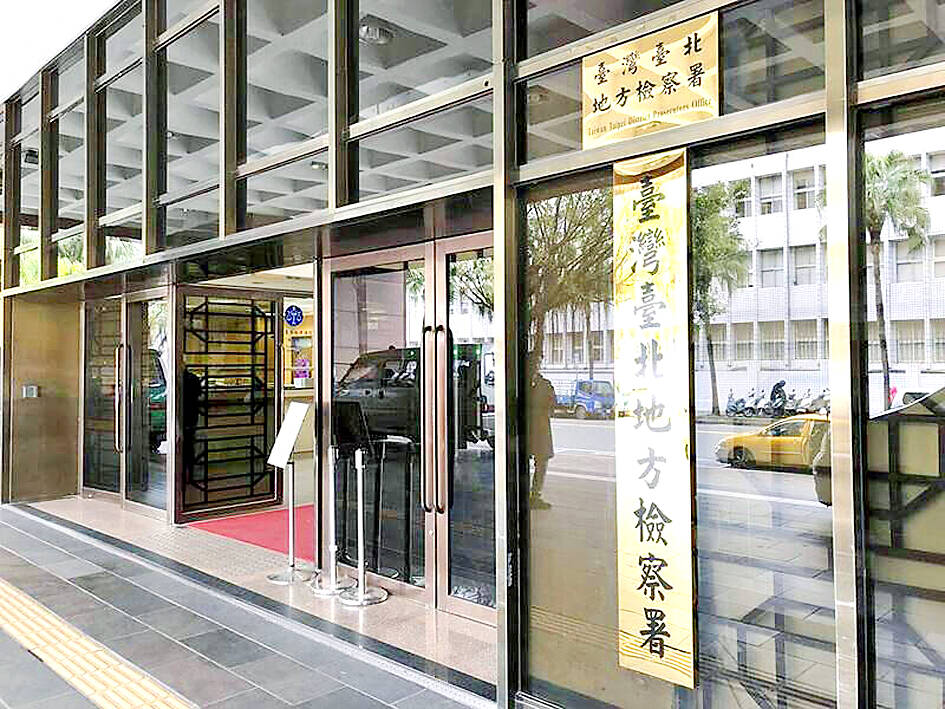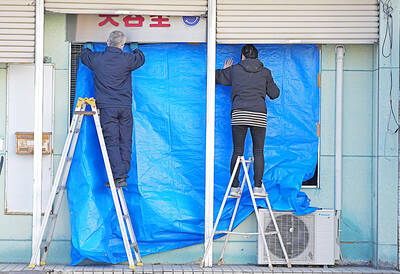Five people, including the head of a construction project, were indicted last week over the partial collapse of a residential building in the Dazhi (大直) area of Taipei’s Zhongshan District (中山) last year.
On Sept. 7 last year, underground excavation work at a Kee Tai Properties Co (基泰建設) construction site caused a neighboring building to sink into the ground and six others to lean to one side. The incident resulted in the evacuation and resettlement of hundreds of people from the buildings.
The Taipei District Prosecutors’ Office indicted Chiu Cheng-hung (邱丞鴻), Chang Po-hsiang (張博翔), Wang Te-sheng (王德生), Chiang Jo-yen (姜若彥) and Liu Feng-shou (劉豐壽), who they said contravened several construction rules while working on the project, including intentionally reducing the thickness of the foundation’s diaphragm wall by 10cm to 50cm, even though the building’s structural drawings clearly showed that it should be 60cm.

Photo: Taipei Times
Chiu, who was in charge of the Dazhi project, and Chang, the construction site’s supervisor, decided to reduce the wall’s thickness during a work meeting on Sept. 30, 2022, prosecutors said.
The men knew that the diaphragm walls, which are reinforced concrete structures built in the ground to support deep excavation, should have been 60cm thick according to the blueprints, but told their subcontractors to go with 50cm, they said.
Chiu and Chang also did not follow the sequence in which the foundation work should have been carried out in an attempt to avoid further construction delays, they said.
The Dazhi project had already damaged nearby homes in April last year, they said.
At that time, Chiu and Chang hired a third party firm to provide weekly monitoring reports, which they altered to make it appear as if everything was in order, prosecutors said.
The reports included soil and geology readings related to surface settlement, building settlement and building incline, some of which exceeded the warning limit shown in a report on Sept. 1 last year, but the men still ordered workers to proceed as usual after excavation work began on Aug. 1, they said.
The pair should have heeded the warning limits and taken action to prevent conditions from worsening, but instead Chiu and Chang continued with the excavation to accelerate the construction work, they said.
Meanwhile, Liu, a technician who worked for a contractor at the site, signed off on a report prepared by Chang in March last year regarding progress on the diaphragm wall, although he never actually inspected the wall, prosecutors said.
When the Taipei City Government received a complaint about the April incident, it ordered Kee Tai and Wang, the project’s supervising architect, to send people to the site to ascertain the situation, they said.
However, Wang never visited the site nor did he send any of his staff, although Chang still asked him to sign off on a preliminary liability report related to the damage caused in the incident, they said.
On June 21 last year, neither Wang nor any of his people showed up to conduct an inspection, instead asking Chiang, a Kee Tai employee, to sign off on a report on his behalf.
The suspects’ actions ultimately contributed to the incident in September last year, prosecutors said.

Taiwanese were praised for their composure after a video filmed by Taiwanese tourists capturing the moment a magnitude 7.5 earthquake struck Japan’s Aomori Prefecture went viral on social media. The video shows a hotel room shaking violently amid Monday’s quake, with objects falling to the ground. Two Taiwanese began filming with their mobile phones, while two others held the sides of a TV to prevent it from falling. When the shaking stopped, the pair calmly took down the TV and laid it flat on a tatami mat, the video shows. The video also captured the group talking about the safety of their companions bathing

US climber Alex Honnold is to attempt to scale Taipei 101 without a rope and harness in a live Netflix special on Jan. 24, the streaming platform announced on Wednesday. Accounting for the time difference, the two-hour broadcast of Honnold’s climb, called Skyscraper Live, is to air on Jan. 23 in the US, Netflix said in a statement. Honnold, 40, was the first person ever to free solo climb the 900m El Capitan rock formation in Yosemite National Park — a feat that was recorded and later made into the 2018 documentary film Free Solo. Netflix previewed Skyscraper Live in October, after videos

Starting on Jan. 1, YouBike riders must have insurance to use the service, and a six-month trial of NT$5 coupons under certain conditions would be implemented to balance bike shortages, a joint statement from transportation departments across Taipei, New Taipei City and Taoyuan announced yesterday. The rental bike system operator said that coupons would be offered to riders to rent bikes from full stations, for riders who take out an electric-assisted bike from a full station, and for riders who return a bike to an empty station. All riders with YouBike accounts are automatically eligible for the program, and each membership account

A classified Pentagon-produced, multiyear assessment — the Overmatch brief — highlighted unreported Chinese capabilities to destroy US military assets and identified US supply chain choke points, painting a disturbing picture of waning US military might, a New York Times editorial published on Monday said. US Secretary of Defense Pete Hegseth’s comments in November last year that “we lose every time” in Pentagon-conducted war games pitting the US against China further highlighted the uncertainty about the US’ capability to intervene in the event of a Chinese invasion of Taiwan. “It shows the Pentagon’s overreliance on expensive, vulnerable weapons as adversaries field cheap, technologically